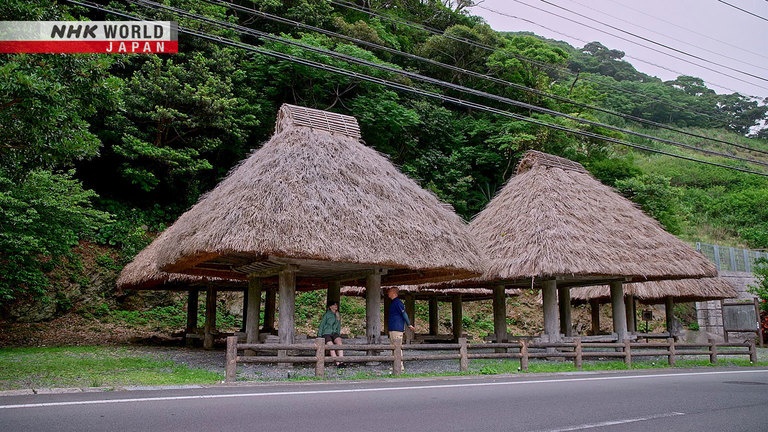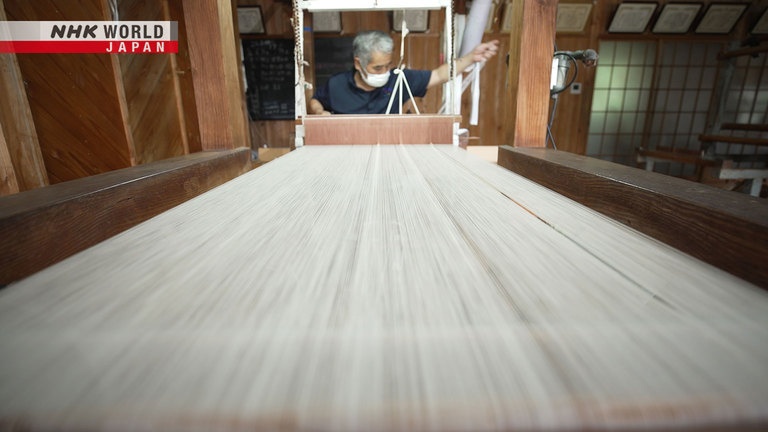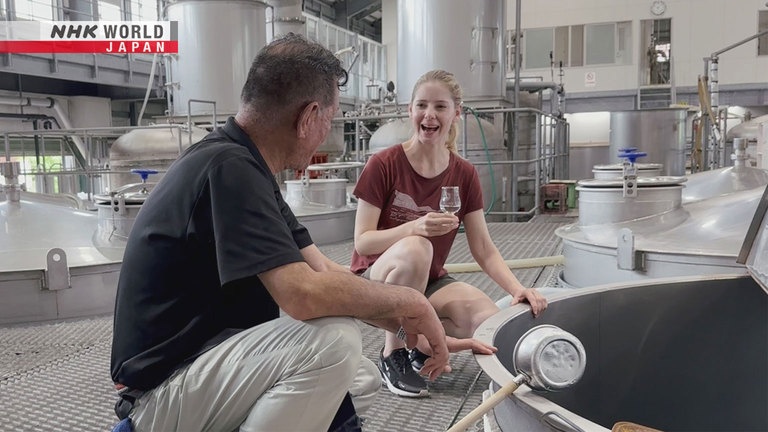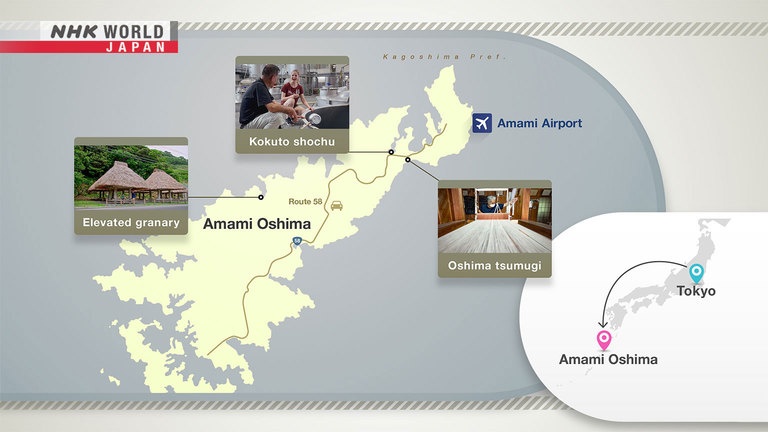Amami Oshima: Beauty in the Rain
Amami Oshima Islands in Kagoshima Prefecture receives one of the largest amounts of rain in Japan. Its rainy season, which runs from May through June, in particular, provides enough water to sustain its lush nature, including rare species of plants and animals, all year round. In this episode of Journeys in Japan, outdoor writer from Sweden Janni Olsson enjoys Amami's rainy season as she engages in activities not available elsewhere and learns about the island's culture.
Elevated Granary

Takakura is a high-floored granary unique to Amami, built to fight its high precipitation and humidity. This is the only place where visitors can see a group of the structure. Designated as a cultural property by the prefecture.
Oshima Tsumugi

A sightseeing facility equipped with a plant of Oshima-tsumugi, a specialty of Amami Oshima Islands with 1,300 years' history. Visitors can view silk weaving process by craftsmen and try their hand at mud dyeing.
Kokuto Shochu Distillery

A distillery of brown sugar shochu, which is made only in Amami Islands. Tours and tasting available.
Access

It takes 2.5 hours by plane from Tokyo to Amami.
Transcript
"Journeys in Japan"
Hello, I am Janni Olsson.
And in this episode, I will travel around Amami
during the rainy season. Let's go.
The rains have arrived in Japan.
Spring is over, but before summer can start,
a season of unsettled conditions sets in,
bringing prolonged downpours across the country.
The island of Amami Oshima,
to the south of Kyushu, gets 3,000 millimeters of rain per year.
And a third of that falls in the months of May and June.
This region is one of the first in Japan where the rainy season starts.
This time on "Journeys in Japan,"
Janni Olsson explores Amami at the height of the rainy season.
It looks really easy, but it's actually quite difficult, like.
I'm having a great time. Everyone is very friendly.
Amami Oshima
Beauty in the Rain
Some 1,300 kilometers southwest of Tokyo,
the Amami region is part of Kagoshima Prefecture.
With forest covering more than 70 percent of the land,
the islands provide a habitat for many rare species of flora and fauna.
In 2021, the region was recognized as a Natural World Heritage site.
Amami split off from the continent long, long ago,
which is why it has a unique ecosystem.
There are plants and animals living here
that cannot be seen anywhere else.
You can also find a subtropical forest,
white sandy beaches, and picturesque villages here.
I'm really excited to see what culture and nature I'll find here.
Janni is from Sweden.
She's lived in Japan for 11 years working as a writer and model.
Hello, nice to meet you.
My pleasure.
Please tell me about the Amami Islands.
First of all, this is a very wet region.
We get around 3,000 millimeters of rain a year.
That's a lot!
Because it rains year-round here, that's why the vegetation is so lush.
And the forests are home to a wide variety of fauna and flora.
Let's go and have a look.
I've seen leaves like these before.
In anime movies, they're often used as umbrellas.
In the old days, people here actually did that.
Like this?
Actually, the juice of the leaves is toxic.
It causes a rash if it touches your skin.
It's best just to look but not touch.
I'm disappointed.
These fungi are bioluminescent.
In Amami, they can only be seen during the rainy season.
For nature lovers, Amami is a treasure house of wildlife.
In the forests of Amami Oshima,
there's a lot going on, even if you can't see it.
You can hear the water and the wind,
the calls of the birds and other animals...
To enjoy the woods to the fullest, you need to use all your senses.
Hello. Are you sheltering from the rain?
I'm glad I found this place.
These are traditional Amami "takakura" storehouses.
Thanks to their thatched roofs and raised floors,
they protect the grain from the humidity.
Are they a bit like refrigerators?
That's right, like old-fashioned fridges.
Until around the 1960s, they were used for storing rice, miso and liquor.
That's interesting. My country, Sweden, is cold.
So we store food underground to keep things chilled.
We had to keep food well above ground level
to protect it from the high humidity here.
Anyway, no need to worry. The rain will soon let up.
It's the rainy season, so I thought it was going to carry on raining for a while.
We islanders know the rain soon stops.
That's why we don't carry umbrellas with us.
Tell me, what are you growing here?
I grow passion fruit, mangoes, plums...
- And bananas and pineapples.
- I see, tropical fruit.
They grow best in this climate.
May I take a look around?
Certainly. Come this way.
I'm growing bananas here. A variety known as apple bananas.
They have a great flavor. But these are still too young to eat.
Which fruit are in season in May and June?
Passion fruit and plums. I'm harvesting them now.
What a size!
It might taste a bit tart. I just picked it this morning.
- Thank you.
- Enjoy.
It's good!
This one's ripe enough to eat.
So full of flavor!
Why do you grow these kinds of fruit in Amami?
The warm, humid climate is just right for growing tropical fruit like these.
So it's due to the climate that they taste so good here?
Yes, thanks to all the rainfall.
The water carries nutrients from the mountains down to our orchards.
That's why the fruit is so tasty.
So in Sweden where I'm from, it rains
quite a lot just like in Amami. However, it's a really
cold region so we can't really grow
tropical fruits like they can here in Amami.
So to be honest,
I'm a little bit jealous.
So let's see what more Amami has to offer.
Oh, look at all those cycads.
They're all over the mountain, actually, here.
Cycads grow everywhere in the Amami Islands.
Because they withstand heavy rain and wind,
they help protect communities from landslides.
So they're quite popular in bonsai, but
I've never seen them all over a mountain like this.
It's quite amazing.
Cycads also play an essential role
in one of Amami's best-known traditional crafts.
Can you tell me what you make here?
This is a workshop where we produce a traditional fabric called "Oshima tsumugi."
It's a craft that dates back some 1,300 years.
The process involves 30 to 40 steps.
It requires meticulous calculation, as well as a high degree of skill.
Depending on the design, a bolt of this fabric can take six months to a year to complete.
That's a long time.
The patterns used in Oshima tsumugi fabric
are created by weaving together different yarns
that have been pre-dyed.
The dye is prepared from the local soil.
That's why this method is called mud-dyeing.
The mud gives the yarn a natural coating
that's water repellent, a bit like fluororesin.
That must be very useful in a place like this, where there's so much rain.
Yes, it's perfect for Amami.
Go ahead!
Like this?
My lower back's aching already.
Keep going!
In the old days, people put cycad leaves
in the muddy fields to boost the iron content.
That's why the word for "cycad" is written
with characters that mean "revive" and "iron."
The distinctive shades of black in Oshima tsumugi
derive from the iron in the mud.
If the dyes from the mud start to lose their luster,
cycad leaves are added to the mud bath.
This is the mud.
It feels so soft.
It's a really smooth mud.
Okay, so
this mud here, it's
really kind of... I'm not sure if you can see, but it's really soft.
It doesn't have a lot of big bits in it, so it's nice both
to the skin and also to the cloth so it doesn't damage it.
So it's really this kind of like...
almost like jelly, or I don't know...
The next step is to squeeze it out.
Like this?
Turn it the other way round.
- It's getting harder.
- If you can do this properly,
you can join us.
It looks really easy, but it's actually quite difficult.
Like, I think he's been doing it for a couple of decades.
OK, it's done now.
How did I do?
Would you like to do it some more?
So it started to rain here again, but
even though it starts to rain really suddenly here in Amami,
it also stops really suddenly.
So it doesn't really bother me that much.
And also, it's thanks to this rain that
Amami can stay this lush and green all year round.
The Amami Islands are the only place in Japan
where sugarcane is used to produce a distilled spirit.
It's called "kokuto," or raw sugar "shochu."
The liquor is distilled from an alcoholic mash
made simply from raw sugar, water
and a starter of rice "koji" mold.
Hello. Is this a shochu distillery?
Yes. We produce kokuto shochu from raw sugar.
It's a big operation. What do you put in the tanks?
The brown color comes from the raw sugar.
Do you make it all year round?
The sugarcane harvest finishes in March.
We have to make the shochu while the sugar is still freshly made.
It's delivered straight after the harvest, while it still has all its fragrance.
It smells really good.
So this is an extremely busy season.
We're all hard at work making shochu.
I'm keen to find out more. What makes the shochu in Amami special?
It's the water.
Amami water is rich in minerals. That's why it tastes so good.
Our kokuto shochu is made from that water,
together with the raw sugar produced in Amami.
So it's really a local specialty?
Absolutely. It's the taste of Amami.
That makes me want to try it.
It has a very smooth flavor. I hope you'll taste for yourself.
Really? Thank you.
This is the unblended kokuto shochu.
It's a bit sharp, but it also has a sweetness.
The longer it's aged, the more it develops its distinctive flavor.
So the background sweetness comes out more?
Yes, it loses its sharpness, and develops a mellow, rounded flavor.
If you compare it to something, rather than the sweetness of wine,
it's more like... it's closer to rum.
Yeah, that's kind of the feeling.
It's still strong alcohol, but it still has that kind of sweetness
because it's made of sugarcanes.
So if you want to start somewhere when you drink shochu, this is great.
It's very good.
Yes, it really is the taste of Amami.
Thank you very much.
This restaurant serves local Amami dishes.
It's very popular.
This dish is called keihan, chicken rice. It's our local specialty.
Keihan is a rice dish topped with ingredients
such as shredded chicken, slivers of omelet, sliced mushrooms, etcetera,
then ladling a rich chicken broth over the top.
It delivers plenty of protein without too many calories.
Should I mix it up first?
Try the broth first. Then mix it all together.
OK. So first, we'll try the soup here.
You can really tell that it has been cooked for like a couple of hours.
There's a lot of flavor in it.
It's good!
It has a refreshing taste that is perfect in these humid conditions.
It's really good!
Thank you.
It's not heavy at all. It's really this kind of...
There's a lot of food and nutrition in here, but it's still really light.
And even if it were like in the middle of the summer, you can still eat this,
yeah, really like calm down a bit after a day outside. So it's great.
Do the islanders eat keihan a lot?
It used to be a dish served for special visitors.
Like when guests come to your home?
And for celebrations, too.
I see. It's really good. Thank you.
Hello, are you all from here?
Yes.
What do people here feel about the rainy season?
The rain is a blessing for the farmers.
It's essential for the animals and vegetation.
Sometimes it might feel a bit gloomy.
But when the rain lets up, the sky and sea in Amami
are the most beautiful blue in the world.
During the rainy season, you might sometimes see a triple rainbow.
But only a very few people have ever seen one.
I enjoy taking the time to listen to the sounds.
At sea, the rain has a different sound compared to when you're in the forest.
I love the rich smell of the earth. In a big city, all you smell is asphalt.
But in Amami, the rain draws out the natural aromas of the soil.
And the air is really fresh here.
I'm having a great time. Everyone is very friendly.
That's the best thing about Amami.
Since the old days, there's been a saying in Amami.
"We only have water thanks to the mountains.
People can only live thanks to the community."
It's an ancient saying that expresses the sense of gratitude
that the islanders feel for others.
I know that a lot of people don't like to travel when it's raining outside.
But rainy days have their own charm
like the smells and sounds of the forest when it's raining or
how the fog comes over the mountains.
And when the rain lets up,
you get to see these breathtaking views.
So, the people living here,
they told me how to enjoy Amami
even when it's raining outside.
So how about you give it a chance too?
I'll bet you'll love it.
To reach Amami Oshima from Tokyo,
flights take two and a half hours.